
Central Asia is a subregion of Asia that stretches from the Caspian Sea in the west to China and Mongolia in the east, and from Afghanistan and Iran in the south to Russia in the north. The region consists of the former Soviet republics of Kazakhstan, Kyrgyzstan, Tajikistan, Turkmenistan, and Uzbekistan. It is also colloquially referred to as "The -Stans" as the countries all have names ending with the Persian suffix "-stan", meaning "land of".

Transport in Afghanistan is done mostly by land and air. Much of the nation's road network was built in the mid-20th century but left to ruin during the last two decades of that century due to war and political turmoil. Officials of the current Islamic Emirate have continued to improve the national highways, roads, and bridges. In 2008, there were about 700,000 vehicles registered in Kabul.

The Turkmenistan–Afghanistan–Pakistan–India (TAPI) Pipeline, also known as Trans-Afghanistan Pipeline, is a natural gas pipeline being developed by the Galkynysh – TAPI Pipeline Company Limited with participation of the Asian Development Bank. The pipeline will transport natural gas from the Galkynysh Gas Field in Turkmenistan through Afghanistan into Pakistan and then to India. Construction on the project started in Turkmenistan on 13 December 2015, work on the Afghan section began in February 2018, and work on the Pakistani section was planned to commence in December 2018. The abbreviation TAPI comes from the first letters of those countries. Proponents of the project see it as a modern continuation of the Silk Road.

Central Asia has long been a geostrategic location because of its proximity to the interests of several great powers and regional powers.
Kyaukpyu is a major town in Rakhine State, in western Myanmar. It is located on the north western corner of Yanbye Island on Combermere Bay, and is 250 miles (400 km) north-west of Yangon. It is the principal town of Kyaukpyu Township and Kyaukpyu District. The town is situated on a superb natural harbor which connects the rice trade between Calcutta and Yangon. The estimated population in 1983 was 19,456 inhabitants. The population of Kyaukpyu Urban area is 20,866 as of 2014, while Kyaukpyu Township's population is 165,352.
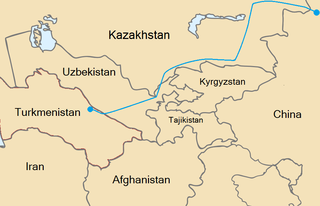
The Central Asia–China gas pipeline is a natural gas pipeline system from Central Asia to Xinjiang in the People's Republic of China. By connecting Turkmenistan to China’s domestic grid, this pipeline makes it possible to transport gas some 7000 km from Turkmenistan to Shanghai. More than half of Turkmen natural gas exports are delivered to China through the pipeline.
Chabahar Port is a seaport in Chabahar located in southeastern Iran, on the Gulf of Oman. It serves as Iran's only oceanic port, and consists of two separate ports named Shahid Kalantari and Shahid Beheshti, each of which has five berths. It is only about 170 kilometres west of the Pakistani port of Gwadar.

India–Kazakhstan relations, also referred to as Indian-Kazakhstani relations or Indo-Kazakhstani relations, are the bilateral relations between the Republic of India and the Republic of Kazakhstan. Diplomatic relations have increased in significance in the 21st century after initially remaining passive in the 1990s. Both nations seek to develop an extensive commercial and strategic partnership in the Central Asia region.
The String of Pearls is a geopolitical hypothesis proposed by United States political researchers in 2004. The term refers to the network of Chinese military and commercial facilities and relationships along its sea lines of communication, which extend from the Chinese mainland to Port Sudan in the Horn of Africa. The sea lines run through several major maritime choke points such as the Strait of Mandeb, the Strait of Malacca, the Strait of Hormuz, and the Lombok Strait as well as other strategic maritime centres in Pakistan, Sri Lanka, Bangladesh, the Maldives, and Somalia.

Energy in Afghanistan is provided by hydropower followed by fossil fuel and solar power. According to Da Afghanistan Breshna Sherkat (DABS), approximately 35% of Afghanistan's population has access to electricity. This covers the major cities in the country. Many rural areas do not have access to 24-hour electricity but this should change after the major CASA-1000 project is completed.

India's 'Connect Central Asia' Policy is a broad-based approach, including political, security, economic and cultural connections. The importance of this policy was strengthened when the Prime Minister of India visited all the five countries— Uzbekistan, Kazakhstan, Turkmenistan, Kyrgyzstan and Tajikistan— in 2015.
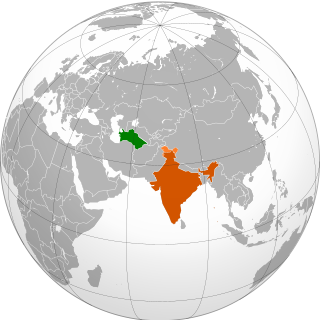
India–Turkmenistan relations refers to the bilateral relationship between India and Turkmenistan. India has an embassy in Ashgabat which opened in 1994. Turkmenistan has an embassy in New Delhi.
China–Pakistan Economic Corridor (CPEC) is a collection of infrastructure projects that are under construction throughout Pakistan beginning in 2013. Originally valued at $47 billion, the value of CPEC projects is worth $62 billion as of 2020. CPEC is intended to rapidly upgrade Pakistan's required infrastructure and strengthen its economy by the construction of modern transportation networks, numerous energy projects, and special economic zones. On 13 November 2016, CPEC became partly operational when Chinese cargo was transported overland to Gwadar Port for onward maritime shipment to Africa and West Asia, while some major power projects were commissioned by late 2017.
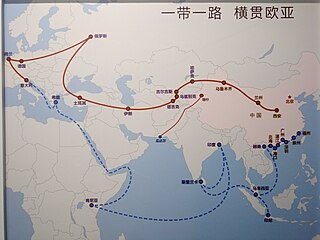
The 21st Century Maritime Silk Road, commonly just Maritime Silk Road (MSR), is the sea route part of the Belt and Road Initiative which is a Chinese strategic initiative to increase investment and foster collaboration across the historic Silk Road.
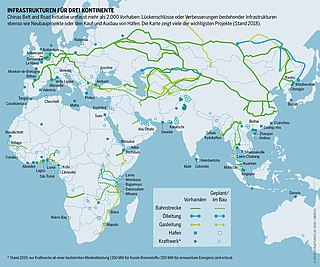
The Belt and Road Initiative, formerly known as One Belt One Road or OBOR for short, is a global infrastructure development strategy adopted by the Chinese government in 2013 to invest in nearly 150 countries and international organizations. It is considered a centerpiece of the Chinese paramount leader Xi Jinping's foreign policy. The BRI forms a central component of Xi's "Major Country Diplomacy" strategy, which calls for China to assume a greater leadership role for global affairs in accordance with its rising power and status. As of August 2022, 149 countries were listed as having signed up to the BRI.

The contemporary nations of Afghanistan and Turkmenistan are the products of The Great Game in Central Asia between the British and Russian Empires. As a result, the two countries have some cultural ties, with Afghanistan having 1.2 million Turkmen, the third largest Turkmen population behind Iran and Turkmenistan.
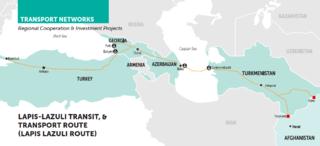
Lapis Lazuli is an international transit route opened in 2018 linking Afghanistan to Turkey via Turkmenistan, Azerbaijan and Georgia.
The Green Silk Road Fund is an investment fund led by Chinese private entrepreneurs to support projects in China and along the countries of the Belt and Road Initiative. It is unique among Belt and Road Initiative investment funds as private sector support is the predominant driver rather than Chinese policy banks and foreign exchange reserves.
The China–Central Asia–West Asia Economic Corridor is an economic and transportation corridor of the Belt and Road Initiative, a global economic connectivity program led by China. The corridor was one of the 6 land corridors articulated in the initial vision for the BRI in 2015. It has since the 2nd Belt and Road Forum in 2019 become one of 35 corridors and project officially included in the BRI.











